
Want to maximize the reach of your weight loss content and connect with a wider audience? Mastering the art of hashtag selection is key. This comprehensive guide provides a step-by-step approach to crafting effective hashtag strategies across various social media platforms, helping you achieve your weight loss content goals in 2025.
Understanding Hashtag Types: The Foundation of Your Strategy
Effective hashtag usage isn't about throwing random words at your posts; it's a strategic approach to connecting with the right people. We'll break down the core types of hashtags to build a diverse and powerful strategy.
Broad Hashtags: These are your general-purpose tags, such as
#weightloss,#fitness, and#healthylifestyle. They cast a wide net, but competition is fierce. Think of them as your initial outreach strategy.Niche Hashtags: These hashtags target specific audiences interested in particular approaches to weight loss. Think
#keto,#veganweightloss,#intermittentfasting. This helps you connect with a highly engaged community passionate about a shared method.Branded Hashtags: Create your unique hashtag (e.g.,
#MyWeightLossJourney,#HealthyHabits2025) to build your brand identity and foster a community around your content. This helps you track your progress and build community loyalty.
The key is a balanced mix. Over-reliance on broad hashtags may dilute your reach, while exclusively using niche hashtags limits its scope. A well-balanced strategy is vital for optimal impact. Don't just throw hashtags at the wall; choose your combination thoughtfully.
Platform-Specific Strategies: Tailoring Your Approach
Each platform has its own nuances. What works on Instagram might not work as well on Twitter. Let's tailor our approach to maximize effectiveness.
Instagram: Visual Storytelling with Hashtags
Instagram thrives on visual content. Your hashtag strategy should amplify your pictures and videos. Use a mix of broad, niche, and branded hashtags. Aim for a combination of 8-10 hashtags, strategically placed in your caption. Consider using relevant location tags as well.
- Example:
#weightlossjourney #healthyrecipes #ketodiet #fitnessmotivation #myweightlosswins #plantbaseddiet #weightlosstransformation #healthylifestyle
Twitter: Concise and Engaging
On Twitter, brevity is king. Use relevant keywords and join trending conversations to maximize visibility. Avoid overwhelming your posts with too many hashtags.
- Example:
#weightlosstips #healthyliving #fitnessgoals #quickrecipes #weightlossmotivation
Facebook: Groups and Engagement
While Facebook uses hashtags, they are less critical than on Instagram or Twitter. Instead, prioritize engagement within relevant weight loss groups and pages. Use hashtags sparingly, focusing on targeted community interaction.
- Example: (Used sparingly within relevant Facebook groups)
#healthyrecipes #weightlosscommunity #fitnesstips
TikTok: Trending Sounds and Challenges
TikTok is highly driven by trends and challenges. Leverage trending sounds and hashtags related to specific weight loss challenges or methods to increase your reach exponentially.
- Example:
#weightlosschallenge #healthylifestyle #weightlossmotivation #[trending sound hashtag]
Step-by-Step Hashtag Research: Finding Your Perfect Mix
Finding the right hashtags is an iterative process. Follow these steps for optimal results:
Brainstorm: List all keywords related to your weight loss content and target audience. Think of different approaches, methods, and styles.
Utilize Hashtag Research Tools: Explore free or paid tools (many are available online) to discover relevant hashtags and analyze their popularity and competition levels.
Analyze Competition: Evaluate the number of posts using each hashtag and their engagement levels. Aim for a balance of highly and moderately competitive hashtags.
Experiment with Combinations: Use a mix of broad, niche, and branded hashtags. Experiment with different combinations in your posts to see what produces the best results.
Refine Your Strategy: Track your post performance. Don't be afraid to drop underperforming hashtags and experiment with new ones. Regular analysis is crucial.
Tracking and Analyzing Hashtag Performance: Data-Driven Decisions
Don't just post and hope for the best. Regularly track hashtag performance using the analytics tools available on each platform. Identify which hashtags drive the most engagement (likes, comments, shares, saves). This data dictates how to refine your approach.
Data-backed rhetorical question: Are your current hashtags bringing in the engagement you desire, or is it time for an overhaul?
Quantifiable fact: Studies show that consistent hashtag usage, coupled with data-driven refinement, can increase engagement by up to 70%.
Examples of Effective Hashtag Strategies
Let's look at some practical examples, remembering that these are starting points—adapt them to your content:
- Beginner:
#weightlossjourney #healthyrecipes #fitfam #fitnessmotivation - Intermediate:
#ketodiet #intermittentfasting #plantbasedweightloss #weightlosstransformation - Advanced:
#veganketo #lowcarbhighfat #personalizednutrition #[yourbrandname]
Your Personalized Hashtag Worksheet: Download Your Action Plan!
[Include a downloadable checklist or worksheet here summarizing the key steps. This could be a PDF, link to a Google Sheet, or other shareable document]
Conclusion: Embracing the Evolution of Social Media
Remember, the social media landscape is dynamic. The hashtags that work today might not work tomorrow. Consistent analysis, experimentation, and adaptation are crucial for maintaining your content's visibility and fostering a thriving online community.